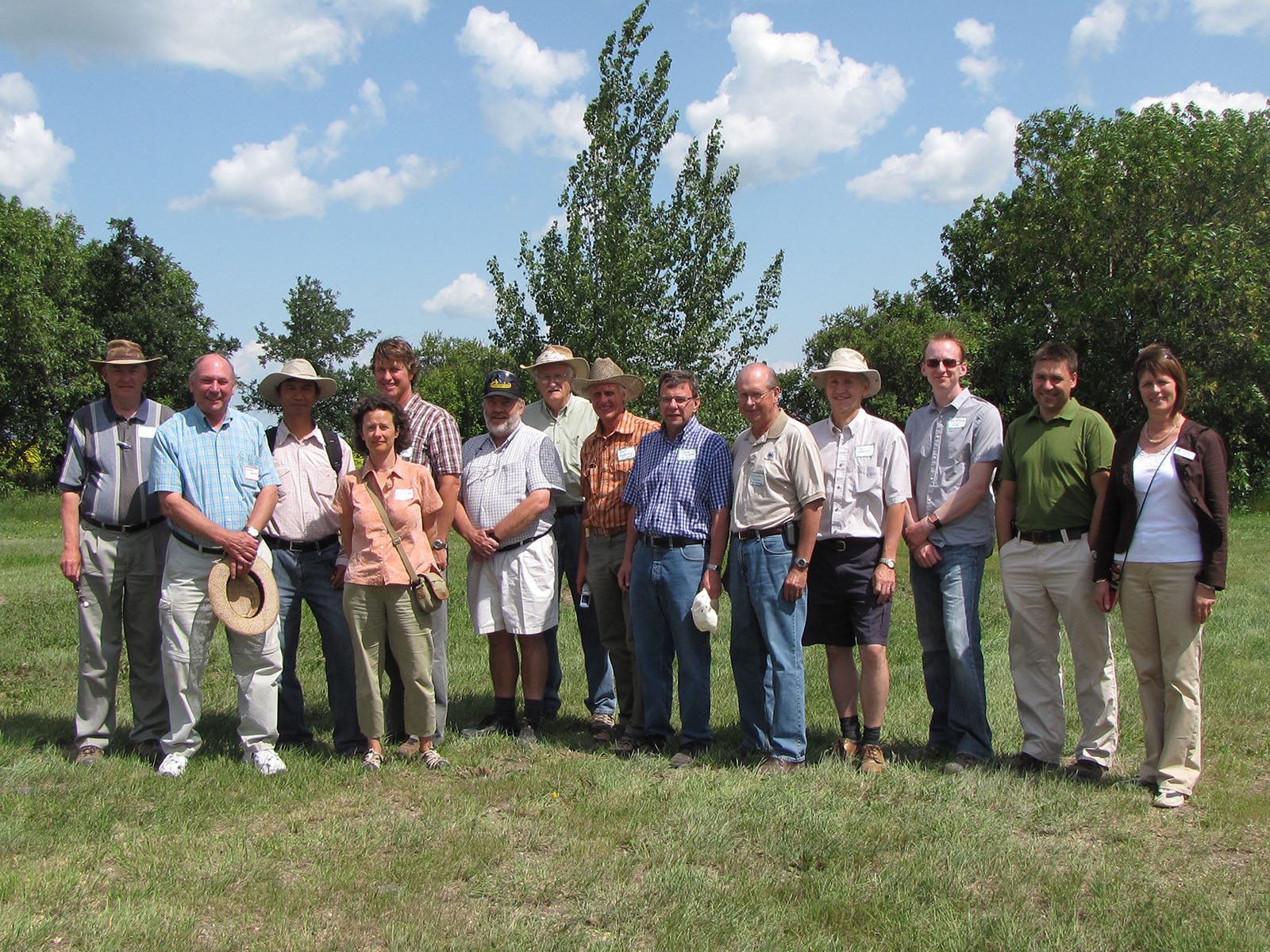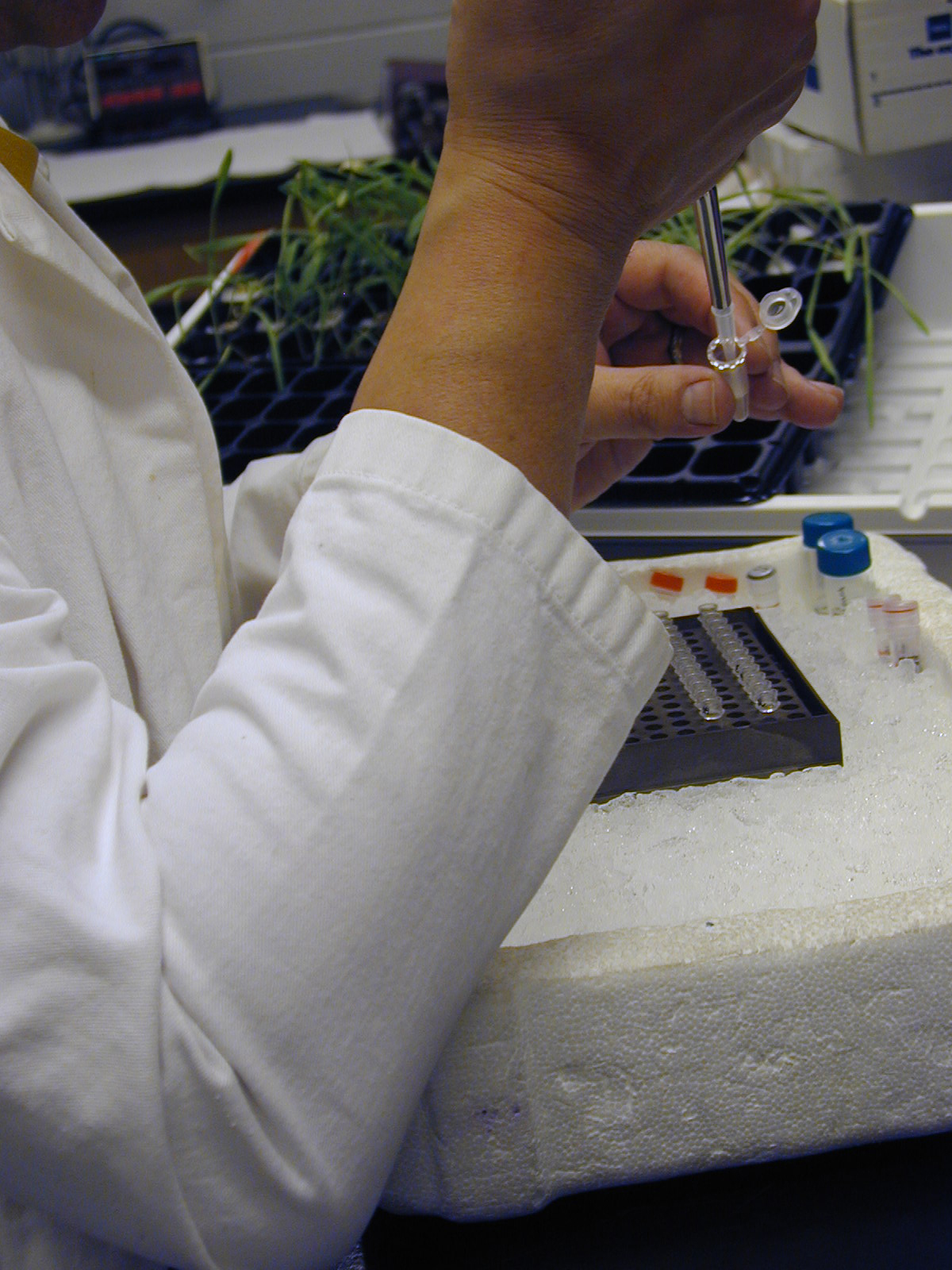
2000s
A decade of growth and expansion.
By Kathy FitzpatrickAs the Crop Development Centre (CDC) entered its fourth decade in the early 2000s, more challenges lay in store. Poor weather hampered both crop yields and research progress early on. As well, changes in funding models presented fresh financial challenges in the first half of the decade. Nevertheless, like a well-adapted crop variety, the CDC not only withstood the onslaught, it continued to flourish, sending out new shoots that would take its growth further and wider.
Drought in 2001 withered crops, but worse was to follow. “The 2002 growing season was one of the most challenging in the history of the Crop Development Centre,” wrote then director Rick Holm in his 2002-2003 CDC annual report. “Extreme drought throughout the early growing season, a severe plague of grasshoppers, frost in early August and a cool wet harvest season combined to play havoc with plant breeding programs, research plots and commercial crop production.”
The 2002 drought prompted the CDC to acquire a second-hand wheel-move irrigation system for the seed farm field. It was purchased in June of that year and was running by early July “just in time to provide enough irrigation water to save the research material that growing season,” said Kirk Blomquist, superintendent of field operations.
Even so, Holm recalled a “feeling of helplessness” about the weather and that only a limited area of the CDC’s cropland was irrigated. He also remembered spending a lot of money trying to control the grasshoppers, “with some limited success”.
Two years of poor yields in the CDC’s commercial crops, combined with the cost of grasshopper control, resulted in less money for research. Several programs and positions were cut, cereal yield testing among them. However, Saskatchewan is “next year country” not only for farmers but for plant breeders as well. Conditions improved somewhat in the 2003 growing season, although April through June was dry and it was timely rainfall in early July that saved the breeding season. Holm wrote in the 2003-2004 annual report: “This continuing dry weather pattern reinforces the critical need to obtain funding for the expansion of irrigated disease nursery facilities.”
This need was fulfilled with the designation of Plant Sciences/CDC land along Preston Avenue in Saskatoon as the site for a new pulse crop disease nursery. In 2007, a mist irrigation system was installed. Soon after, an 1176-foot linear irrigation system was installed on land within the city limits, for use in both pulse crop pathology research as well as for early generation wheat and durum breeding material.
Holm also noted in his 2003-2004 CDC annual report “the beginning of a significant change in the way Saskatchewan Agriculture, Food and Rural Revitalization (SAFRR) funds research at the University of Saskatchewan and in the size of the operational grant that will be made available to the Centre. The net result will be a significant reduction in the funding available to support our operations.”

In the previous fiscal year, the provincial department provided a strategic research grant of $2.4 million, comprising close to a quarter of the CDC’s $10 million budget (the balance coming largely from producer checkoffs, contributions from producer groups, royalties on varieties, industry, and Ducks Unlimited). The strategic research grant was changed to a $1 million operating grant and seven scientist-technician positions. Consequently, the winter cereal and stress physiology/biotechnology programs lost their core funding from SAFRR, and the scientists who led them moved to faculty positions in the Department of Plant Sciences at the University of Saskatchewan.
The two programs were closely linked, Holm noted. Winter cereals and plant physiology related to cold hardiness were two important targets when the CDC was created, he said, but “25, 30 years later after a lot of really good research had been done, winter wheat had not really established itself as a major crop … scientifically, it was very sound but the uptake by farmers just hadn’t been there,” so funding by SAFRR was redirected to other areas.
However, with the continued support of Ducks Unlimited, winter wheat breeder Dr. Brian Fowler was able to wind down his program gradually, continuing development of new varieties into the following decade, before devoting full-time attention to cold tolerance in cereals.
The loss of the stress physiology program closely coincided with the patent application for the plant gene ROB5, which increases stress tolerance. Discovered in the early 1990s by plant physiologists Dr. Albert Robertson (PhD) and Dr. Larry Gusta (PhD), it remained a focus of Gusta’s work for the next 15 years and was subsequently licensed to a worldleading crop science company.
Even with these challenges, the CDC continued to grow in its fourth decade, fuelled by additional revenue from external sources. For example, support from Saskatchewan Pulse Growers (SPG) more than doubled with the renewal of its pulse breeding agreement with the CDC for a 15-year term. The new funding model provided a gain in the form of a new cereal-flax pathology position. The CDC was able to hire a third pulse crop breeder, with co-funding from SPG.

In addition, royalty income grew to be “fairly substantial” said Holm. The federal Plant Breeders’ Rights Act had come into force in 1990. By 2009-10, royalties to the CDC totalled about $900,000 – nearly matching the $1 million annual operating grant from the Saskatchewan Ministry of Agriculture. Royalties were re-allocated right back to the breeding programs, providing the necessary funding for growth and expansion.
The decade was marked by several other infrastructure improvements. A $2-million project lead by then plant sciences professor Dr. Doug Waterer (PhD) more than doubled the College of Agriculture and Bioresources’ greenhouse space to 6,666 square metres. Completed in 2003, it was a significant boon to the CDC, and the propagation of plant breeding material remains the facility’s largest single use.
In 2004, a $3 million expansion of the Crop Science Field Laboratory began, with support from the federal department of Western Economic Diversification, Saskatchewan’s Agri-Food Innovation Fund, and many generous organizations and individuals. Completed in fall 2005, it provided an additional 1330 square metres of much needed space for the pulse breeding and research programs. Prior to the expansion “people were crammed into that building, they were just really short of space,” said Holm.
In 2006, the federal and provincial agriculture ministers announced funding of $5 million for the addition of a 1,466 square metre Grains Innovation Laboratory (GIL). Several grower organizations and private sector seed companies also contributed funding to this project. Opened in 2009, it includes a wet chemistry lab, a baking lab and a malting lab along with milling and grinding rooms.
GIL co-manager Gene Arganosa says prior to its opening, crop quality testing was conducted in three different labs adjacent to each other on the third floor of D Wing in the College of Agriculture and Bioresources Building. The samples had to be transported from the Crop Science Field Lab and back again. In some cases, the samples had to equilibrate to room conditions for two or three days before being analyzed. Having everything under one roof now has improved efficiency and the increased lab space has improved overall throughput.
GIL staff handle thousands of samples every year, screening for traits that are important to the end users of the grains. “We generate the data that will enable the breeders to determine whether the line that they’re dealing with will move forward in the breeding process or not,” explained Arganosa. “Like a lottery, the more lines that you actually screen or seed, the more likely you’re able to come up with a variety that will have quality traits that are better than or equal to the control varieties.”
In 2007, for the first time in its history, leadership of the CDC passed to someone who was not a faculty member and already working within the organization. As the CDC expanded in scope, the dual roles of research and administration were thought to be too much for one person to oversee. Dorothy Murrell, a seed company executive and agrologist, became the first managing director.
Murrell recalls touring the CDC’s facilities and “being completely astounded” by the enormous investment in plant breeding. “I came away feeling humbled,” said Murrell.
A turn to new applications of technology also marked the CDC’s fourth decade. Genome mapping and molecular markers helped breeders select for desired traits more efficiently. As well, work was underway on the use of doubled haploidy techniques in peas, chickpeas and lentils. Both Holm and Murrell mentioned the deep satisfaction they felt about the rapid uptake and leading roles taken by CDC scientists in new techniques and technologies to locate genes of interest and incorporate them into breeding lines. These are world-class, leading-edge scientists and programs.
Research goals shifted during this decade to include not only agronomic traits of interest to those growing and selling the crop, but also traits of interest to end users. A few examples: high beta glucan oats to reduce artery-clogging cholesterol; low glycemic durum to produce pasta with low glycemic index (helping to limit blood glucose levels, especially important for people with diabetes); and low phytate barley, primarily for use in hog feed, to reduce phosphate (a pollutant) in manure.
Calling her role at the CDC a highlight of her career, Murrell explained her main focus. “The resource base and scope of the CDC was a well-kept secret, unknown to many in industry when I began. One of my hopes when taking the position was to develop its profile with both public and private funding agencies and the agriculture value chain, so as to increase the impact that the CDC could have on agriculture in Canada and really, worldwide.”
She noted there were private sector companies that did not want to run their own plant breeding programs, but wanted to sell varieties. “They all felt they had a role to play to bring good new genetics to farmers … They were interested in forming partnerships with breeding programs at the Crop Development Centre and other public sector agencies,” said Murrell. Varieties were licensed to companies, which would then take them to market, carrying forward an approach that had been established in earlier decades. Royalties were then returned to the breeding programs.

“The Crop Development Centre scientists were ready to take up these partnerships. They saw benefit, not only in dedicated funding, but in the marketing potential for varieties which the value chain brought to the table,” said Murrell. “These partnership agreements greatly increased funding for the CDC.”
Checkoffs also expanded to cover virtually every crop kind including canary seed, bringing increasingly engaged crop producers to the CDC table as funding partners.
Meanwhile, throughout its fourth decade, the CDC continued to release new varieties at a brisk pace, including spring wheat and lentils tolerant to imidazolinone (a herbicide); waxy hulless food barley; low-phytate feed barley; durum low in cadmium (a toxic metal taken up from soil); and a Canadian western red spring wheat tolerant to the insect wheat midge.
To understand the CDC’s impact after its first 40 years, one needed look no further than the fields across western Canada. Ninety-six per cent of chickpea acres, 95 per cent of lentil acres, 87 per cent of flax acres, and 75 per cent of winter wheat acres were seeded with CDC.
Holm attributed much of the success to the fact that the Province has funded crop research to the tune of “millions and millions and millions of dollars” over the years. “That model is the envy of many universities, not just in Canada but elsewhere,” said Holm. Holm is himself noted for his work to improve weed control in pulse crops. For that, as well as his efforts in establishing the pulse crop laboratory, he was recognized.
By the end of the CDC’s 2000’s, the passing of the crop research mantle from one generation to the next was well underway with a wave of retirements, and new arrivals, who would carry the work of their predecessors to new levels.
